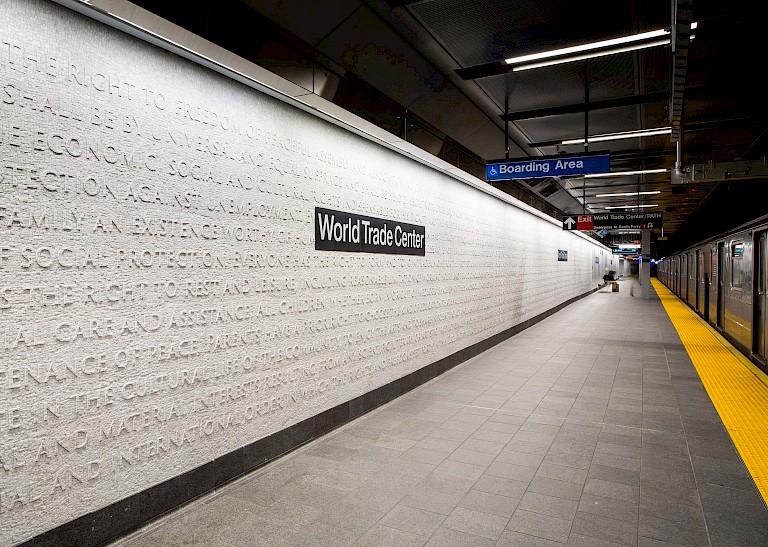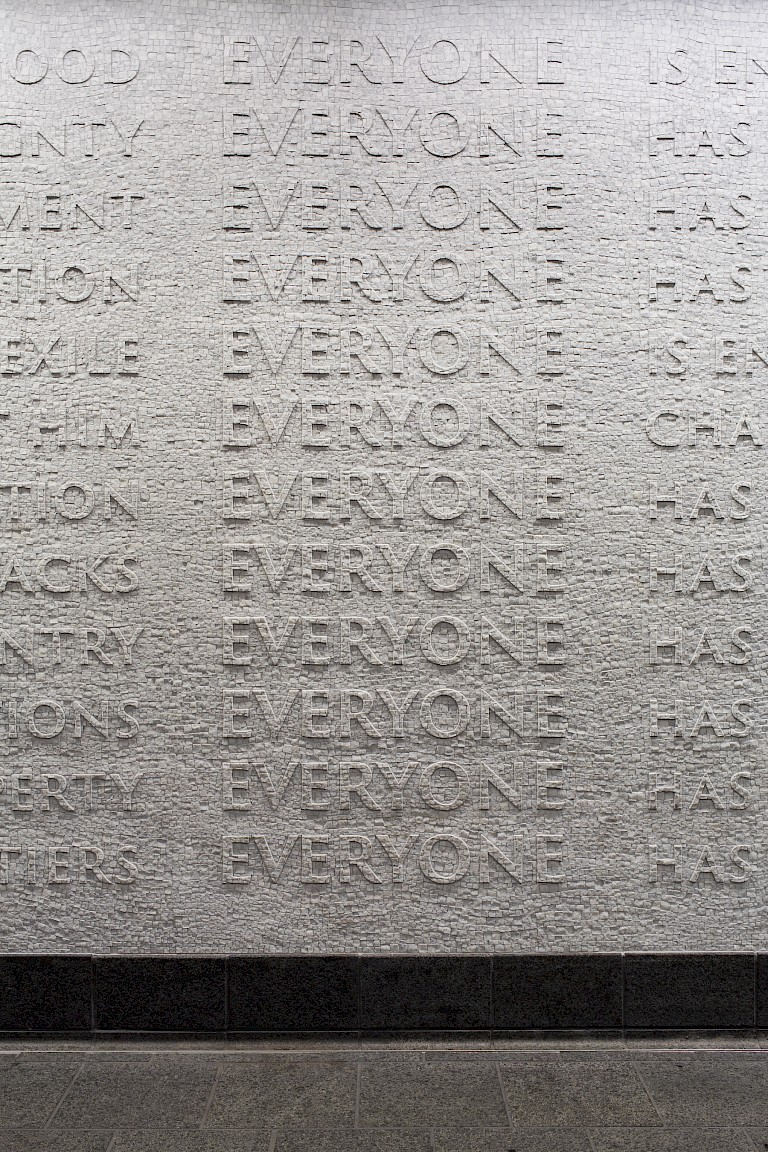



Ann Hamilton’s CHORUS serves as a threshold for the former site of the World Trade Center Towers. On September 11, 2001, the towers that formerly anchored lower Manhattan’s financial district were destroyed in a terrorist attack that ultimately took the lives of nearly 3,000 people, injuring thousands more. The impact rippled outward from the site. Both 110-story skyscrapers collapsed, starting fires in adjacent buildings and spreading dust and debris across the surrounding area. Rebuilding—emotionally and physically—has been a long road.
Over the two decades since 9/11, the site has been transformed. A memorial opened to the public on September 11, 2011. In 2014, a museum opened, as well as One World Trade Center, a skyscraper matching the height of the original towers. In 2016, The World Trade Center Transportation Hub and Oculus, designed by Santiago Calatrava, opened along with retail spaces. Hamilton’s CHORUS and the WTC Cortlandt subway station where it is installed, opened in September 2018.
In approaching this location, Hamilton was aware of the emotional and historical weight of the project, as well as the need to create a work that would offer a meaningful entry point for visitors traveling to the memorial, along with local residents and commuters who might engage with the work on an almost daily basis.
Drawing on an extensive career working with text and cloth, Hamilton developed a concept responding to the space and the questions it raised. Speaking to the influence of her background in textiles, she alluded to “the structuring properties of textiles having a democratic spirit,” explaining that, “Every knitted loop and every thread must do its part for the cloth to hold.” The intersections and strength of warp and weft, of national and international documents, create the structure of CHORUS. Here, words replace threads to form a conceptual and text-based foundation for civic life, one continuously made anew.
While conducting research into source texts, Hamilton was drawn to the negotiations, diplomacy, and ultimate complex agreement underlying the ratification of the United Nations Universal Declaration of Human Rights (1948). Phrases from this document became the horizontal text that flows along both sides of the subway platform, structured by key phrases from the preamble to the United States Declaration of Independence (1776), which form periodic vertical spines. On the Southbound side, these spines both bring the eye to key phrases, such as “with certain inalienable rights,” and “these are life, liberty, and the pursuit of happiness” as well as repeated words. On the Northbound platform, the word “everyone” recurs from ceiling to floor, foregrounding the expansive significance of rights such as freedom of thought, peaceful assembly, and freedom of movement. Hamilton wrote, “In the repetition, a chorus, and a refrain sounds: everyone, equal, rights…These underground crossings of texts and people are the social, legal and institutional pillars that underlay cultural life above ground.” (Hamilton, 2018).
DEVELOPMENT PROCESS
Hamilton’s proposal for the subway station was selected by a panel of arts professionals engaged by the Metropolitan Transportation Authority (MTA) in July 2014, moved by the manner in which her “design gave context to the station’s place physically and historically, and provided calm in an emotionally charged space” (MTA, 2018).
In developing the proposal, Hamilton spoke with local stakeholders—museum representatives, MTA staff, and community members—to both hone the idea and ensure that the community supported the project’s emerging direction. She also spent time walking through the area, gleaning as much as she could about the location, the community’s needs, and what was called for by both the site and the historical moment.
Once Hamilton composed the central idea and form of CHORUS, collaborators played key roles in the practical development of the project. Artist and designer Hans Cogne, with whom Hamilton had previously collaborated on the book Ann Hamilton: An Inventory of Objects (2006) and VERSE, a text-based project for a library floor, provided core support in developing the project’s aesthetic. Notably, Cogne suggested the project’s Trajan font, a contemporary font inspired by inscriptions on Roman monuments. Cogne further supported Hamilton’s meticulous process of developing the project’s layout: testing letter spacing, printing samples, assessing font size, troubleshooting intersections of horizontal and vertical text, and methodically creating an overall experience that would flow across the station walls. These formal decisions allowed Hamilton to knit the narratively discontinuous lines into continuity.
Artisans at Franz Mayer of Munich served as vital collaborators for the project’s physical form, inviting Hamilton to their studio and working with her closely throughout the project’s development. Together they selected materials and worked through the challenges of crafting mosaic text that would progress horizontally for the viewer, despite the platform’s changes in elevation. Mayer of Munich further developed a method for creating a three-dimensional white-on-white design. Letters protruding from the wall’s mosaic surface were crafted using a water-jet cutting system and then hand-set to elevate and align each letter back into the mosaic pattern from which it was cut. MTA supported this process as well, obtaining necessary permissions and exceptions for the use of Carrara marble, in lieu of the subway system’s more common material of glass for mosaics.
In addition to the painstaking details outlined above, Hamilton faced the larger challenge of designing a layout for the project spanning the two sides of the subway platform and weaving together instances of particular words within the horizontal text with instances of the same words within vertical spines. This design was further complicated by limited access to the construction site and a large elliptical passageway in the middle of the Northbound platform, resulting in distinct designs on the two platforms.
The final project stretches across 4,350 square feet, crafting a meeting point for national and international concepts and ideals in 10 tons of marble. The white-on-white design works in harmony with the white design, vaulted ceiling, and natural light of the nearby Oculus and transportation hub. CHORUS is both an experience in itself and an entry point for the site, a moment of serenity that introduces questions to linger in the minds of visitors.
ARTWORK EXCELLENCE
Acknowledging the importance imbued in the site by so many, and the challenge to create a meaningful work that would respond to both the site and the needs of the community, Hamilton commented, “I think the most important thing is to be humble in front of what you’re being asked to do, to be humble in public space, and to contribute a quietude that might be needed.” Cultivating a calming atmosphere within the busy station, Hamilton underscored her desire to offer audiences a chance to shift their “quality of attention,” to feel “held momentarily,” in an encounter that combines contemplation with tactile embodiment.
She therefore offers visitors an open-ended experience, aligning phrases from declarations to form interwoven prompts for reflection. In so doing, she brings the weight of history down to an individual level. Describing the process of walking along the wall and reading the text as “an act of composition,” Hamilton explained that each person “stiches the words together in their own order.” The consequential vocabulary of influential texts here becomes personal, animated by each visitor whose unique relationship with the text becomes a “form of enactment.” Historical language is hereby recirculated and given a new life through each person’s distinct, contemporary lens.
This enactment is both conceptual and physical, with anecdotes describing visitors reaching out to touch the words of the mosaic. Hamilton noted that just as one reaches a hand forward to haptically affirm a piece of their world, so, too language provides an affirmation, offering up the words that a community needs during a time of crisis or a time of healing. In both sharing and reconfiguring elements of foundational texts, CHORUS invites visitors to cultivate their own relationships with these words, while considering on a larger scale what it would mean to actualize these ideals in the civic life above.
Reflecting on the work’s longevity, Hamilton commented, “I feel like in some ways maybe [CHORUS is] the most important project that I’ll ever get to do…You hope to make a work that will not only speak to its present moment but will be resonant 10 years, 20 years, 30 years from now, and that you can find form for that. And you can’t know…Every work is a risk that you’ve found the question and the form.”
CHORUS in form and invited action blends the individual with the communal. Repeated phrases draw attention like a refrain, both highlighting their significance while also opening them up to scrutiny. Inviting a tactile, embodied relationship with chosen texts, the work positions passersby to forge a dynamic relationship with foundational texts that both parallels broader civic life and honors each individual. Just as a CHORUS is comprised of many distinct voices, so too, this reimagining of texts and enacting of ideals is rooted in the participation of many individuals. CHORUS positions declarations as starting points for a larger, ongoing conversation and in doing so speaks both to the present and to generations to come.
CONTEXT
The WTC Cortlandt station served 1,245,455 riders from its opening in September 2018 through the end of that year, with ridership reaching 4,232,521 in 2019 (MTA, 2020). While numbers have fluctuated due to the COVID-19 pandemic, the site remains a conduit for a steady flow of commuters, city tourists, and visitors to the World Trade Center site. CHORUS is a newer work, yet its frequented and significant location positions the project to continue a long dialogue with current and future visitors.
CHORUS was developed in the aftermath of a tragedy, and was nominated for the International Award for Public Art amidst dual crises—the COVID-19 pandemic and a nationwide movement for racial justice that is calling for systemic reforms and a reckoning with both historic and contemporary injustices. Reflecting from this standpoint, Hamilton stressed that “our present is haunted by the past we have not dealt with.” Referencing “the complex historical inheritance of an American history whose economy comes out of an economy of slavery,” Hamilton asked “How do we account for the pain while we aspire to an idealism and a set of democratic values?...What vocabularies do we need now to address where we are?” In this vein, CHORUS’ chosen texts serve a dual role, both inspirational ideals to strive towards and a mirror reflecting those stark realities where the nation has fallen short of these aspirations.
Calling attention to the power of words wrapped up in the power of institutions, CHORUS evokes possible alternatives, positioning its visitors as actors who each bear a role and a responsibility. As Hamilton wrote in the project’s description, “Poets use words to remind us of where we are and imagine a future we can’t yet touch. In this work, every passerby is a poet” (Hamilton, 2018).
**Unless otherwise noted, quotations above are derived from an interview with the project researcher on May 11, 2021, and subsequent correspondence on May 14, 2021.
SELECT REFERENCES
Hamilton, Ann. CHORUS (Project description). 2018. Accessed May 10, 2021. http://www.annhamiltonstudio.com/public/chorus.html
MTA. “MTA Arts & Design Debuts Marble Mosaic at WTC Cortlandt 1 Subway Station.” MTA Press Releases. September 8, 2018. Accessed May 10, 2021. https://www.mta.info/press-release/nyc-transit/mta-arts-design-debuts-marble-mosaic-wtc-cortlandt-1-subway-station
MTA. “Subway and bus ridership for 2019.” April 14, 2020. Accessed May 10, 2021. https://new.mta.info/agency/new-york-city-transit/subway-bus-ridership-2019.
“Annual Subway Ridership.” 2018. Accessed May 10, 2021. http://web.mta.info/nyct/facts/ridership/



